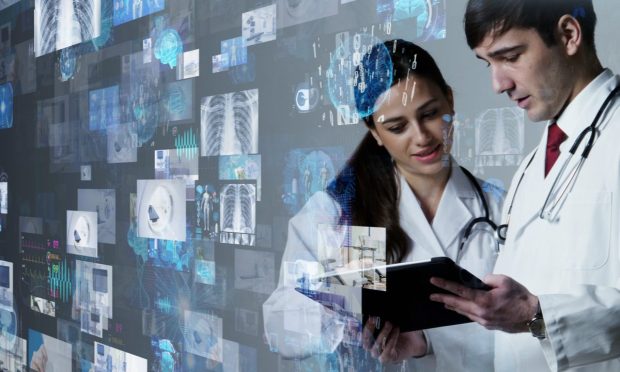Blazing 5G Network Connectivity Is Powering A Wave Of Telehealth Innovation

Healthcare is transforming before our very eyes. Trends such as telehealth, Internet of Things (IoT)-based medical devices and remote surgery that makes use of state-of-the-art imaging equipment have put medicine at the cusp of innovation, and it’s all thanks to one breakthrough — 5G connectivity.
So-called telemedicine has existed for some years already, but seeing a doctor over the internet was far from common pre-COVID-19. The pandemic altered that, as health organizations began urging patients and staff to use emerging telehealth platforms to serve people. Adoption has accelerated across the world, and 5G is fueling that growth by providing the necessary cellular network availability, bandwidth and ease of deployment.
5G networks are already here and they’re a vast improvement over existing 4G LTE. They offer a 10-20 times performance improvement over older networks, meaning information can be transmitted in speeds that approach real-time.
Further reading: Nokia Soars On 5G Propulsion
Telehealth goes hand in hand with remote monitoring. Because of their speed and capacity, 5G networks can support larger deployments of IoT devices and infrastructure. These deployments are set to propel the growth of emerging fields such as remote patient monitoring and home healthcare.
One interesting startup in the telemedicine space is People Power, which uses artificial intelligence (AI) tech to monitor people for up to 24 hours a day, providing them with a remote support team that helps to monitor their well-being. People Power’s AI solution is more advanced than most others on the market. It relies on sensors that can send an emergency alert if an elderly patient living alone suffers a fall, for example. Further, it uses AI to alert the patients themselves if it believes there’s a danger that they may fall.
AI previously wasn’t possible in these scenarios. Smaller devices lack the processing power, and it’s only because of 5G, which can send data to the cloud at ultra-fast speeds where it can be quickly processed, that these kinds of applications are now a reality.
See more: Jonas Bro Super Bowl Ad Puts App-Based Healthcare In The Spotlight
All kinds of medical devices are being made possible by 5G. Chipmaker Maxim Integrated has come up with a silicon platform that’s designed to tap into fast networks to power a range of medical gadgets that need fast connectivity. Devices such as heart/pulse rate machines, blood oxygen monitors and electrocardiograms (ECG) can all be worn at home thanks to their ability to connect to the cloud where data can be analyzed more rapidly in order to warn wearers of a problem. 5G is essential in this respect because these types of devices are too small to contain the computing power necessary to perform what they’re tasked with.
Examples of such devices include Fitbit’s Sense smartwatch which can monitor blood oxygen levels, ECG, skin temperature and even stress with a Wi-Fi connection. Apple’s latest smartwatch, the Apple Series 6, has similar capabilities.
More like this: Oura Sleep Rings And The Expanded Future Of Wearables
Virginia-based Caretaker Medical offers a more advanced device called the Caretaker 4, which enables non-invasive “Beat-by-Beat” blood pressure and heart rate monitoring. It means a patient can be monitored remotely by a care giver or family member 24 hours a day, with 5G providing the robust real-time connection.
The telehealth landscape will become even more reliant on 5G. Verizon, one of the first U.S. carriers to achieve nationwide 5G network coverage, is plotting to take advantage of that by making its own entrance into telemedicine with its teleconferencing subsidiary, Zoom competitor BlueJeans, which it acquired in April 2020. It’ll be an interesting development, as BlueJeans will have the unique advantage of being able to tap into Verizon’s super-fast 5G networks.
You might also like: Verizon’s BlueJeans Video Conference Unit Sets Sights On Virtual Healthcare
5G further solves privacy problems relating to telemedicine. One of the biggest concerns over telehealth relates to the security of those platforms. People don’t want their confidential medical information being leaked, so verification capabilities are a critical must-have for all telehealth providers. AI, enabled by 5G, can potentially help to provide this.
Read more: Report: Healthcare Providers Use AI To Solve Telemedicine’s Privacy Problem
Healthcare’s most impactful 5G application though, may well be its ability to support remote surgery. It could be a potential life saver for people living in more remote areas where there is limited access to healthcare specialists.
Remote surgery is not a novel idea, but technology is constantly improving it. For instance, in video-assisted surgery, a 5G connection makes it possible to support higher resolutions of up to 8K, which will provide remote experts with more detailed, clearer visual information of the surgical site, making it possible to perform more reliable operations. And 8K compatible medical instruments are already a reality, with Japanese firm Kairos debuting the world’s first 8K microscope in 2019, providing up to 300-times magnification.
All these developments are real and taking place now, but they provide just a glimpse of what 5G-enabled remote healthcare will look like. In future, the unprecedented speeds of 5G will be used as the basis of smart city infrastructure that promises to change the way emergencies are handled. By making critical information available in real-time, teams will be able to respond far more rapidly than is possible today.
Remote healthcare functions will ultimately be performed by AI, machine learning and robotics, which can make decisions faster and operate with greater precision. Future 5G infrastructure will make this happen, ensuring emergency teams and caregivers are more prepared and better able to deal with the unexpected.